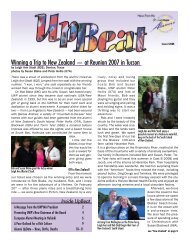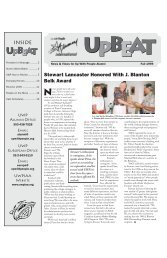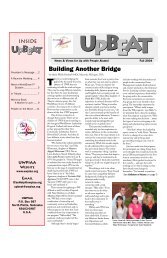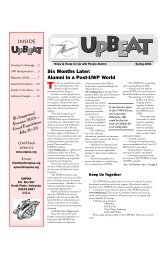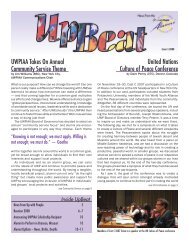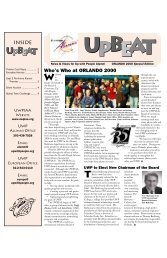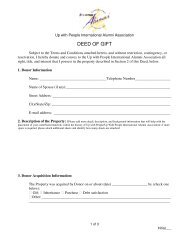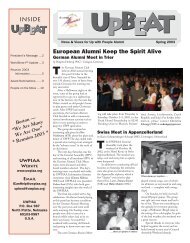2003 Fall draft - Uwpiaa.org
2003 Fall draft - Uwpiaa.org
2003 Fall draft - Uwpiaa.org
Create successful ePaper yourself
Turn your PDF publications into a flip-book with our unique Google optimized e-Paper software.
y David Bliss Allen<br />
Editor’s note: This is the first in a twopart<br />
series on the musical heritage of<br />
UWP.<br />
The dozen songwriters who<br />
contributed their songs to the<br />
original Sing Out ’65 were longtime<br />
friends and contemporaries. For the<br />
previous ten to fifteen years they had<br />
written full-length musical plays,<br />
concert-like musical revues and<br />
“special occasion” music – working<br />
together or alone.<br />
By August 1965, they sensed<br />
they had combined the best of their<br />
music in a promising musical review.<br />
Yet none of them could foresee<br />
that Sing Out ’65 was destined<br />
within a year to become a runaway<br />
“hit” on three continents, a critical<br />
success that one New York music<br />
reviewer called “one of the most<br />
exciting musical reviews experienced<br />
theater buffs have seen in decades.”<br />
Nor did any of them dream that,<br />
from its opening performance on<br />
August 7 in a small Cape Cod town,<br />
the show would be in continuous<br />
production for the next 34 years,<br />
making it perhaps one of the longest<br />
running musical productions in the<br />
U.S. and the world in the 20th<br />
century.<br />
The Sing Out Explosion<br />
Sing Out took off like a rocket. In<br />
three months, it traveled from Cape<br />
Cod to the New York World’s Fair<br />
where it performed to 20,000 people<br />
– then to Washington, D.C., where<br />
96 senators and congressmen hosted<br />
a performance for 4,000 in the<br />
Washington Hilton ballroom.<br />
Crossing the country by train (the<br />
“Sing Out Express”), the cast<br />
performed in the Hollywood Bowl<br />
for 15,000. Then came three national<br />
television shows and the first<br />
500,000-copy Sing Out album. This<br />
was followed by a lightning trip to<br />
Japan to perform in Japan’s traditional<br />
Kabuki Theater – and then<br />
before the prime minister of Japan<br />
and a crowd of 12,000 in the Metropolitan<br />
Gymnasium, then to Korea<br />
to perform before the prime minister,<br />
and more thousands.<br />
In the course of the next 10<br />
months, Sing Out grew from one<br />
cast of 300 to three casts of more<br />
UP BEAT<br />
Up with People’s Musical Heritage ...<br />
Sing Out’s Early Songwriters<br />
From left: Ralph, Herbie, Steve and Paul<br />
than 1,000. It crossed the United<br />
States again and again, performing<br />
in football stadiums, sports arenas,<br />
civic auditoriums and universities,<br />
and at the three U.S. military<br />
academies. In 1966, it traveled to<br />
Europe for mammoth live performances<br />
and national TV shows in<br />
Germany, Austria and Spain.<br />
By the end of two years Sing<br />
Out had toured to 17 countries on<br />
five continents. An estimated 150<br />
million people had seen their shows<br />
live and over repeated national<br />
television specials in many countries.<br />
And what came to be known as “the<br />
Sing Out explosion” was fully<br />
underway.<br />
Within the first year after “liftoff<br />
” in Cape Cod, 150 regional Sing<br />
Outs had sprung up from coast to<br />
coast – and 100 more around the<br />
world. Everyone, it seemed, was now<br />
singing “Up with People” and the<br />
Sing Out songs. During one record<br />
week in September 1966, regional<br />
Sing Outs across the U.S. performed<br />
before 100,000 people. Worldwide,<br />
there were eventually 400 local and<br />
regional shows with an estimated<br />
60,000 cast members. It was<br />
Harambee Africa in Kenya, Sing-<br />
Out Korea in Seoul, India Arise in<br />
India, Sing-Out Venezuela, Sing-<br />
Out Panama, Sing-Out Jamaica and<br />
five casts of Sing-Out Puerto Rico<br />
in Latin America. “Down under” it<br />
was Sing-Out Australia. In Tokyo<br />
Let’s Go ’66 was performing weekly<br />
on national television. By late<br />
August 1966, a Pennsylvania editor<br />
told the Sing Out ’66 cast, “You are<br />
on the verge of becoming one of the<br />
world’s most powerful forces.”<br />
This was the explosive beginning<br />
of UWP in the 1960s. But who were<br />
these original writers of the show?<br />
And where did the inspiration, ideas<br />
and the essential “magic “ of their<br />
songs come from?<br />
The Men and Their Music<br />
Every “Uppie” alum knows the<br />
names of Paul Colwell, and his<br />
brothers Ralph and Steve – and the<br />
“musical genius,” Herb Allen. The<br />
four are near-legendary figures who<br />
deserve the major credit for creating<br />
and producing the music of UWP at<br />
the beginning and through the years.<br />
Like others in the remarkable<br />
founding team of creative artists,<br />
they developed their talents in the<br />
years after World War II, writing<br />
musical plays, revues and “special<br />
occasion” music for Moral Re-<br />
Armament – an <strong>org</strong>anization that<br />
was a powerful and effective force in<br />
bringing reconciliation and the<br />
concepts of “inspired democracy” to a<br />
war-shattered world in the 1950’s<br />
and 1960’s. MRA gave remarkable<br />
hope and a purpose to thousands,<br />
premised on the simple idea of<br />
putting your own life right – and<br />
then devoting your life to putting the<br />
world right, to mending the wounds<br />
and cares and divisions of the 20th<br />
century. MRA was a significant<br />
element in bringing reconciliation<br />
between France and Germany after<br />
the war, in uniting former enemies<br />
all over the world, in helping to<br />
rebuild the institutions of postwar<br />
Japan. ... which explains why we first<br />
find young Herb Allen putting his<br />
musical training to work in warshattered<br />
Italy in the early ’50s,<br />
writing and singing songs in Communist<br />
strongholds and industrial<br />
suburbs of Milan.<br />
The Colwells burst on the scene<br />
in the mid-1950s, leaving behind a<br />
promising career in Hollywood,<br />
where they were recording for<br />
Columbia Records and performing<br />
on NBC’s weekly “Tex Williams<br />
Show.” In the dozen years before<br />
creating the music for UWP, they<br />
traveled 174,000 miles to 37 different<br />
countries on six continents. They<br />
sang songs in 47 languages - Zulu,<br />
Maharathi, Navajo, Japanese, Swahili<br />
and Maori, to mention a few. They<br />
performed before such world leaders<br />
as President Eisenhower; Chancellors<br />
Adenauer and Erhard of Germany,<br />
Prime Ministers Kishi and<br />
Sato of Japan; President Magsaysay<br />
of the Phillipines; President Prasad<br />
of India – all in all, a total of 27<br />
heads of state, prime ministers and<br />
presidents.<br />
The “special occasion” music<br />
they wrote was varied and eclectic –<br />
songs for the important people they<br />
were meeting, songs of hope and<br />
inspiration for the world, songs for<br />
entire countries. One of them, “Vive<br />
le Congo,” became something of a<br />
national anthem for the former<br />
Belgian Congo as it gained independence<br />
from Belgium. The Colwells<br />
spent 14 dangerous months in the<br />
often-violent country, giving 483<br />
broadcasts over the national radio,<br />
singing in many of the Congolese<br />
languages. The minister of information<br />
later said, “... without the work<br />
of these men, there would have been<br />
far worse catastrophe following<br />
independence.”<br />
Paul Colwell developed his<br />
songwriting genius during these<br />
adventurous years, singing before<br />
kings, queens, presidents and ordinary<br />
people. Years later, celebrated<br />
cellist Pablo Casals spoke of the<br />
“inspiration and delicacy” of the<br />
music of UWP and asked, “Who is<br />
your chief composer?” When told of<br />
Paul Colwell, Casals said, “He is a<br />
precious genius. Bach and Beethoven<br />
would have loved his music.”<br />
In the next issue: David Bliss<br />
Allen explains the evolution of Sing<br />
Out into UWP and pays tribute to the<br />
people who contributed to its legacy.<br />
10 fall ‘03



